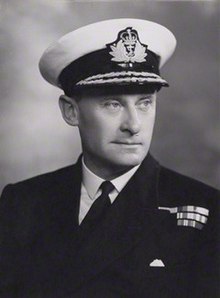Nigel Henderson
Sir Nigel Henderson | |
|---|---|
 Sir Nigel Henderson in 1957 | |
| Born | 1 August 1909 |
| Died | 2 August 1993 (aged 84) |
| Allegiance | United Kingdom |
| Service/ | Royal Navy |
| Years of service | 1927–1971 |
| Rank | Admiral |
| Commands held | Chairman of the NATO Military Committee (1968–71) Plymouth Command (1962–65) Director General of Training (1960–62) HMS Kenya (1955) Royal Naval Air Station at Bramcote (1952) HMS Protector (1951) |
| Battles/wars | Second World War |
| Awards | Knight Grand Cross of the Order of the British Empire Knight Commander of the Order of the Bath |
Admiral Sir Nigel Stuart Henderson, GBE, KCB, DL (1 August 1909 – 2 August 1993) was a Royal Navy officer who served as Chairman of the NATO Military Committee from 1968 to 1971.
[]
Henderson joined the Royal Navy in 1927.[1] He served in the Second World War as a gunnery officer.[1] After the war he became Naval Attaché in Rome and then, from 1951, commanded the patrol vessel HMS Protector.[1]
Henderson was appointed Commanding Officer at the Royal Naval Air Station at Bramcote in 1952 and was Captain of the cruiser HMS Kenya from 1955.[1] He became Vice Naval Deputy and then Naval Deputy to the Supreme Allied Commander Europe in 1957 and Director General of Training at the Admiralty in 1960.[1] In 1962 he was made Commander-in-Chief, Plymouth.[1] He was made Head of the British Defence Staff in Washington, D.C. and UK Military Representative to NATO in 1965 and then Chairman of the NATO Military Committee in 1968.[1] He retired in 1971.[1]
Writing in 1974 Henderson expressed concern over a general lack of awareness about "Western Europe and indeed of all NATO countries being dependent very largely on Middle East oil".[2]
Personal life[]
Henderson married Catherine Mary Maitland in 1939. They had three children, a son and two daughters. In 1959 Lady Henderson inherited the estate of Hensol House near Castle Douglas from her godmother Helen, Marchioness of Ailsa. The couple retired there in 1971.[3][4]
In retirement Henderson spearheaded the effort to restore the Scottish birthplace of John Paul Jones at Arbigland back to its original 1747 condition.[5] He was also a Deputy Lieutenant of the Stewartry of Kirkcudbright[6] and a Patron of the Ten Tors Challenge held each year on Dartmoor.[7]
References[]
- ^ Jump up to: a b c d e f g h Sir Nigel Stuart Henderson Liddell Hart Centre for Military Archives
- ^ Editorial Naval Review, Vol. 67, No.3, page 169, July 1979
- ^ "Lady Henderson obituary". The Telegraph.
- ^ Galloway volunteer group celebrates 21st birthday Galloway News, 15 December 2006
- ^ History of John Paul Jones Cottage John Paul Jones Cottage Museum, Scotland
- ^ Deputy Lieutenants in Scotland Hansard, 11 June 1992
- ^ Ten Tors
- 1909 births
- 1993 deaths
- Deputy Lieutenants of Kirkcudbright
- Knights Commander of the Order of the Bath
- Knights Grand Cross of the Order of the British Empire
- NATO military personnel
- Royal Navy admirals
- Royal Navy officers of World War II
- British naval attachés